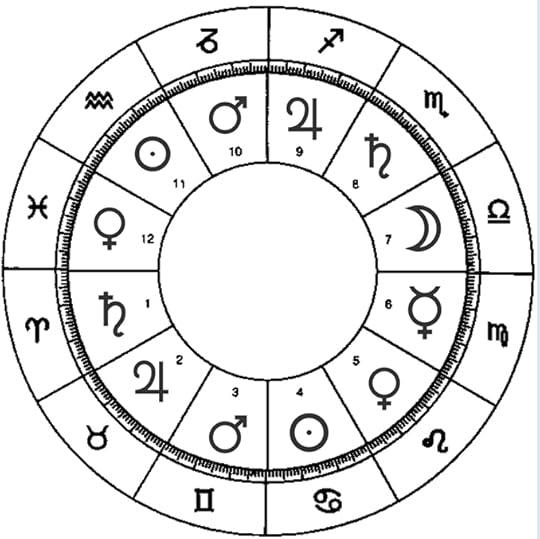Planetary hours and the 12-letter alphabet of astrology
Back in the 1970s astrologer Zipporah Dobyns popularized the “12-letter alphabet” of astrology, which consisted of equating the 1st house with the first sign, Aries, and its ruler Mars. Each subsequent house was paired with its sign in the same order as in the Aries-rising chart and with that sign’s ruler. Dobyns did not originate this idea. A version of it appears in William Lilly’s 1647 Christian Astrology in which he discusses “con-significators” of each of the houses based on their correspondence with the Aries-rising chart and the Chaldean order of the planets beginning with Saturn in first place.
Such pairings were common in the Renaissance literature. Body parts, for example, were assigned in the same order to signs, starting with Aries, and the 1st house, which each could signify the head. Similarly, Scorpio and the 8th house could each signify the genitals, and Pisces and the 12th house were each assigned to the feet.
While such bodily pairings between houses and signs were widely accepted, at least some authors objected to the wholesale equivalence of signs and houses. For example, Culpepper, a contemporary of Lilly, wrote:
“Some authors hold an opinion that the signs carry the same signification in order that the houses of heaven do, and Aries should signify life, Taurus estate, Gemini brethren and short journeys, you know the rest. Truly, my own opinion is that many authors invented whimsies, and when they had done, set them down to posterity for Truth; who taking them up without trial, clothed tradition in plush and left poor reason to go in rags. An author said so; ergo ’tis true, right or wrong.” (Nicholas Culpeper, Astrological Judgement of Disease, x.iv)

I’m not sure when the pairing of Aries with the 1st house, Taurus with the 2nd, etc., first appeared in the astrological literature, but it was certainly present in English-language texts of the 17th century.. Regarding the pairing of planets with houses, Abu Ma’shar discusses such associations as underlying reasons for house significations. For example, in Dykes recent translation of Ma’shar’s Great Introduction (p.390), he asserts that the significations of the houses derive from “(1) the order of the planets spheres, and their (2) indications, (3) natures, and (4) conditions.” It is important to note that Ma’shar does NOT use the rulers of the 12 signs, starting with Aries, but instead uses the planets in the Chaldean order of their orbs in the Ptolemaic system, in which Saturn is the first planet and is therefore paired with the first house. This system is quite different from the modern “12-letter” alphabet.
 In Willaim Lilly’s 17th-century system of consignificators, the signs are linked to houses in the same numerical order, starting tiwht Aries as the 1st sign. Planets are paired with houses according to their Chaldean order, with Saturn as the first planet being associated with the first house.
In Willaim Lilly’s 17th-century system of consignificators, the signs are linked to houses in the same numerical order, starting tiwht Aries as the 1st sign. Planets are paired with houses according to their Chaldean order, with Saturn as the first planet being associated with the first house.In the Ptolemaic universe Saturn is the first planet and it travels in the outermost sphere. Planets are arranged in Chaldean order from the slowest to the fastest (or from the outermost to the innermost): Saturn, Jupiter, Mars, Sun, Venus, Mercury and the Moon:

Abu Ma’shar (9th century) gives an elaborate explanation of how each house got its significations from the associated planetary orb. Saturn, the first and outermost planet, has to do with the relative darkness inside the womb and the baby’s eventual emergence into the world at birth. In addition, Ma’shar notes that Saturn, which rules gravity, has something to do with the male sperm falling into the female womb and causing conception.
Jupiter, the 2nd planet, symbolizes wealth, which is a meaning of the 2nd house. Mars, the 3rd planet, is linked to siblings and in Jyotish, to courage and bravery, which are attributes of the 3rd house. The Sun, the 4th planet, is a father symbol. Venus, the 5th planet, is related to the pleasures and love affairs of the 5th house, which can produce offspring.
Mercury, the 6th planet, because of its proximity to the Sun is constantly getting burned by the Sun’s rays and is analogous to a person who is constantly succumbing to various illnesses. The Moon, the 7th planet, is a symbol of women and marriage (as the consort of the Sun).
The cycle repeats beginning with the 8th house, associated with Saturn, a malefic planet connected with death and probably with miscarriages and maternal mortality in childbirth. Jupiter, a symbol of travel, religion and learning falls in the 9th house. Mars, a symbol of the forceful assertion of authority, is linked to the 10th. The Sun, a symbol of friendship, benevolence, and recognition falls in the 11th. Finally, Venus is linked to the 12th house “which withdraws from the Ascendant and does not look at it” (p. 394) and apparently Venus in this position can signify enemies, sorrow, envy, slander, cunning and riding animals (perhaps a patriarchal view of unsupervised women or the nature of Venus, which spends a lot of time close to, and hence burned by, the Sun). Interestingly, in Jyotish the 12th house (paired with Venus in the Chaldean order of the orbs of planets) is a house of the pleasures of the bed.
Anthony Louis's Blog
- Anthony Louis's profile
- 29 followers



